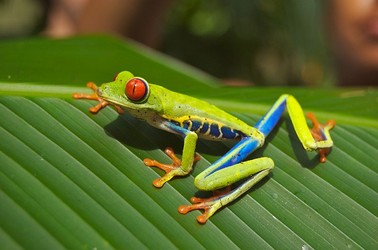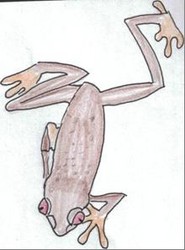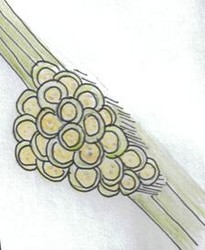

Mature Red-Eyed Tree Frog, Agalychnis callidryas.
Classification
The Red-Eyed Tree Frog can be classified as (Wikipedia):
- Kingdom: Animalia
- Phylum: Chordata
- Class: Amphibia
- Order: Anura
- Family: Hylidae
- Genus: Agalychnis
- Species: A. callidryas
General Description
The Red-Eyed Tree Frog (Agalychnis callidryas) is commonly known as the “monkey frog” for its jumping abilities. It is a relatively small amphibian, measuring no more than eight centimeters. The male is usually about two and a half centimeters smaller than the female. A colourful amphibian, it is most recognizable by its bright green color and red eyes. Its other markings include blue and cream coloring around the groin and rib areas as well as its orange feet. However, this color pattern is developed with age; the younger Red-Eyed Tree Frogs are mostly brown. Their lifespan in the wild is usually around five years. Red-Eyed Tree Frogs have many characteristics to accompany their climbing habits. Their long limbs allow them to climb and swim with agility as do the sucker pads on the bottom of each digit. The skin on their stomachs is a lot thinner than the skin found on their backs which is more resistant and thick. They have long sticky tongues to help them latch onto their prey for an easier hunt.
Endangerment Status
The Red-Eyed Tree Frog is not endangered, however the rainforest habitat is shrinking due to a mixture of deforestation, and environmental issues.
Habitat and Predators
The Red-Eyed Tree Frog can be found in the rainforests of Central and South America. They are a mainly arboreal amphibian which means that they are “tree dwelling” frogs. However, as tadpoles, they are found in the water and only with age do they migrate to the trees. They are a nocturnal amphibian and sleep during the day.
Their diet is carnivorous consisting of everything that fits into their mouths such as moths, flies, crickets and sometimes even small frogs. Young frogs commonly eat fruit flies and pinhead crickets. Since Red-Eyed Tree Frogs are not venomous, they use their bright colors as a defence mechanism to stun their predators (startle coloration). Seeing as their predators use vision to hunt, once their eyes latch onto their prey, they are often startled by the shockingly bright colors which caused a “ghost image” to be left where the Red-Eyed Tree Frog was originally. This allows the tree frog to make an escape.
Their predators commonly consist of Bats, Snakes, Birds, Owls, Tarantulas, and small Alligators.
Adaptations to Environment
The Red-Eyed Tree Frog is a lot more complex than it seems. It contains a third eye lid called the nictitating membrane. This membrane allows them to shield their eyes from danger while still being able to see. This is useful when in a mating battle or when being hunted. The coloring of their eyes also plays a large part in their survival. The bright red causes their predators to second-guess the prey and stuns them to give the Red-Eyed Tree Frog a chance to escape. The red color also allows them to see at night which is useful since they are nocturnal amphibians.
The Red-Eyed Tree Frog has a few other adaptations which help guarantee their survival. Firstly, they are able to hide their blue and cream markings when they sleep so that they camouflage against the leaves for better protection. They also are able to change their colors depending on their mood or environment which offers a more secure lifestyle. The Red-Eyed Tree Frog also prevents itself from dehydration by staying under leaves and keeping its limbs close to its body.
Reproductive Characteristics and Life Cycle
The Red-Eyed Tree Frog breeds in the months of October through March. The males attempt to attract the females through their ‘croak’. Once they have found their female, they fight other frogs to be able to latch onto the female’s hind legs. The female will then proceed to latch to the underside of a leaf while other males will try to latch onto her. The female is responsible for holding onto the weight of all the frogs including the one that is latched onto her while they fight. They then take part in a process called amplexus where the mating couple hangs upside down underneath a leaf over a body of water. The female will lay a clutch of eggs on the underside of the leaf and then the male will fertilize them. Oftentimes, the female will become dehydrated and will drop herself with her mate into the body of water. At this point, the male needs to stay latched onto her or he might lose her to another frog. It is common that a female will return to the leaf with a different mate than before. Once the eggs have hatched, the tadpoles proceed into the water where they will mature into froglets. Oftentimes, the tadpoles do not survive because of various predators to be found inside the water; the ones that do survive develop and grow into Red-Eyes Tree Frogs. Once they are froglets they move to the trees with the rest of the Red-Eyed Tree Frogs where they will remain for the rest of their lives
Importance to the Ecosystem
The Red-Eyed Tree Frog helps prevent over-population of its prey such as insects and small frogs. It also serves as a ‘mascot’ for many conservation agencies such as “Save the Rainforest” since its habitat is diminishing.
Diary of a Red-Eyed Tree Frog
This is a portrayal of the struggles, triumphs, and tribulations of a common Red-Eyed Tree Frog named Juan. Beginning within his egg, in Costa Rica, he gives insight onto the lifestyle of his species, up until his death.
Monday, October 21st, 2007
As I peer through the white film that encompasses my being, I see the water beckoning to me from a small distance. I prepare myself for my escape, and I feel my prison releasing around my frail frame. I do not know what lies ahead, but my instinct tells me that the water is good for me. I freefall for a second or two plunging head first, surely for my death. I find myself flopping inside the water and ask myself: “Am I not in heaven?” Alas, I see an angry fish coming my way, and my instinct yells at me to swim as fast as my little fin can go. I assume he does not want to be amigos. I dodge behind a small pebble and close my eyes, waiting for my end. A few moments pass and I realize that I am still able to swim. Up ahead I see my fellow brothers and sisters and swim up to join them in what will be our fight for survival.


Red-Eyed Tree Frog tadpole, Agalychnis callidryas. © Olivia Selbie.
Saturday, January 9th, 2008
Today is the day that I must leave my life in the water to go live in the trees with my family and friends. To be honest, I am a bit scared to be eaten for I have had a good life as a tadpole. However, my brain activity has increased and I am now much more agile. I have tried jumping around but I am not yet fully developed so I do not hop great distances yet. The first leap I took out of the water and onto a nearby leaf was exhilarating. I take a few more leaps, breathe in and throw myself into my new life.


Young Red-Eyed Tree Frog, Agalychnis callidryas. © Olivia Selbie.
Thursday, March 17th, 2008
This is the last month of mating season, and I have yet to find a mate. Every battle that I have put myself into over a lady frog has been a failure. I am still too young and too weak to hold on tightly enough. I’ve had my eye on Maria, a beautiful tree frog (Ok fine, we all look pretty much the same) who has not yet laid her eggs. I’ve been singing my beautiful croaking serenade whenever I am around her, hoping to woo her into having our own little tadpoles. I will go and try to fertilize her eggs now.
Friday, March 18th, 2008
We have succeeded in laying the tadpole eggs! After an epic battle between four other frogs and me, I latched onto Maria’s back and waited as she carried us around looking for a home for our eggs. We found the perfect location, right next to a nice pond that will serve as the home to our froglets for the 85 days of their youth. She hangs us upside down and begins laying her eggs; I fertilize them as they drop. They are encompassed in a sticky liquid that will hold them together in a clutch. Halfway through our process, she drops us spontaneously into the pond to rehydrate. I fight through the waves and other frogs trying to keep latched onto her back. Finally, she jumps out of the water, with me still on her back, and we finish laying the eggs. Sometimes at night, I sit around my tadpoles and watch as they develop slowly into beautiful creatures. It reminds me of the day that I first dropped into the water; I hope my tadpoles have the good fortune that I did.
Tuesday, February 2nd, 2013
I have reached the end of my journey. I have lived a good life and have helped lay many eggs, some of which have been successful in their lives as well (Nothing has eaten them yet). It is now just a waiting game for me to pass on and for everything to darken. Maria, my dear, passed away a few days ago and now it is my time. I had a good five years of life. For my last meal, I will eat a cricket.
Information on the Internet
- Red-Eyed Tree Frog National Geographic. A reputable source that is easy to understand. Accessed 11 Sept. 2008
- Red Eyed Tree Frog A good profile of tree frogs, very helpful. The Belize Zoo. Accessed 11 Sept. 2008
- Red-Eyed Tree Frog (Agalychnis calidryas) The Red-Eyed Tree Frog in a nutshell.
- The Red-Eyed Tree Frog: Not your Typical Frog! Kids Club News. Apr. 2006. 1. Eastern Savings Bank. Apr. 2006. Eastern Savings Bank. Accessed 14 Sept. 2008
- Red-eyed Tree Frog Honolulu Zoo. 2 Apr. 2008. Honolulu Zoo. Accessed 11 Sept. 2008
- Agalychnis callidryas Wikipedia. Accessed 14 Sept. 2008
- Agalychnis callidryas Boman, Bonnie L. Animal Diversity Web. 2002. University of Michigan. Accessed 14 Sept. 2008
- Red-Eyed Tree Frog: Rainforest Ambassador The Nature Conservancy. Autumn 2007. Accessed 14 Sept. 2008
- Red-Eyed Tree Frog's Life Cycle National Geographic. Accessed 14 Sept. 2008





 Go to quick links
Go to quick search
Go to navigation for this section of the ToL site
Go to detailed links for the ToL site
Go to quick links
Go to quick search
Go to navigation for this section of the ToL site
Go to detailed links for the ToL site